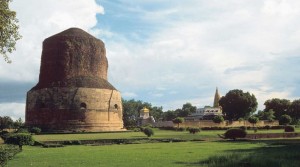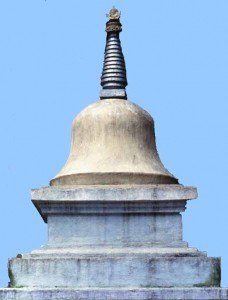The eight types of stupas represent the eight major events in the Buddha’s life and the four major and four minor locations where He gave teachings or the eight pilgrimage sites:
1. The Stupa of Heaped Lotuses, symbolizes Buddha’s birth and the seven steps he took in each of the four cardinal directions. It was built during the Buddha’s lifetime at Lumbini and is shaped like a lotus.
2. The Stupa of Enlightenment, symbolizes Buddha’s achieving enlightenment at Bodhgaya. This stupa was built by the King Bimbisara in Bodhgaya in honor of Buddha attaining enlightenment. It expresses the removal of the last, thin veils of obscuration and obstacles in Buddha’s mind on the evening before he reached enlightenment. It symbolizes the goal of Buddhist practice – recognizing one’s own mind, complete enlightenment. It means freedom from all disturbing feelings and their roots as well as full development of the mind’s abilities. At the same time, the stupa is a symbol for overcoming all obstacles and all obscurations.
 3. The Dhamek Stupa of the Turning Wheel (Stupa of Wisdom or Stupa of Sixteen Gates), symbolizes the Wheel of Dharma turning for the first time at Deer Park near Sarnath.
3. The Dhamek Stupa of the Turning Wheel (Stupa of Wisdom or Stupa of Sixteen Gates), symbolizes the Wheel of Dharma turning for the first time at Deer Park near Sarnath.
4. The Stupa of Miracles, built by a person named Lisabi in Shravasti where the Buddha performed miracles in order to convince people with wrongful views sometimes referred to as the “Miracle of the Pairs.”
5. The Stupa of Descent, this stupa at Samkasya has many steps which symbolize the Buddha’s return to the earthly realm after teaching the Abhidharma to His mother in the Tushita Heaven.
6. The Stupa of Reconciliation or Unity, symbolizes reconcilling a split in the Sangha at the Bamboo Grove at Rajgir (Rajagrha) after some difficulties caused by Buddha’s cousin Devadatta. Also known as the site where the Buddha tamed the maddened elephant Nalagiri, which is considered as an allegory for the schism that arose among the monks living there.
7. The Stupa of Complete Victory, symbolizes the Buddha voluntarily prolonging His life at Vaishali for three months at the request of His students. Sometimes this phase is represented as the stupa at Vaishali where monkeys offered the gift of honey.
8. The Stupa of Parinirvana, symbolizes Buddha’s parinirvana at Kushinagara. The main body of the stupa has the shape of a bell, the symbol of Buddha’s complete wisdom.
The common elements of these eight types of stupas are the foundation up to the lion throne and the upper part from the rings upward. The middle section of the different types of stupas may be different. Sets of representatives of these eight stupas were either individually established or created as part of one stupa.
